May 29, 2015 by in Analysis with 7 comments
Disclosure: This post is brought to you by National Ultimate Training Camp. All opinions are those of Ultiworld. Thanks for supporting the brands that make Ultiworld possible!
Ultiworld is pleased to announced the second annual Ultiworld Player of the Year and other individual college awards. The award criteria can be found here — we considered both regular season and postseason performance in our selection of awards. Though the input of Ultiworld reporters is weighed heavily, final decisions for awards were made by the editors.
All winners will be sent a custom-designed VC Ultimate jersey as a prize for their outstanding seasons.
Player of the Year
Alika Johnston (Virginia)
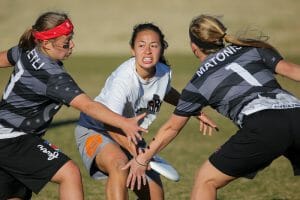
There’s not a lot to say about Alika Johnston that someone else hasn’t already said. The 2015 Callahan winner has had a lot of breath and ink used in the act of praising her prolific and relentless performance. And rightfully so, as Johnston’s play has spoken for itself all season long. On both sides of the disc, she’s been a top producer and drastically influenced the fate of her team. Opponents have most been forced to submit to her, going with the “stopping six other people is more likely than stopping her” strategy.
That’s because Johnston will get you, one way or the other, because of her combination of quickness, skill, and intelligence. Her game IQ may be her most underrated ability, but her ability to identify the best line of decision making at a rate fast enough to keep up with her game is fascinating. The moment she identifies your weakness, she’s already capitalizing on it, whether it is to set up a give and go for herself or maneuvering a handler defender into bad position to not only stop her reset cut, but stop her ensuing continue to the break side.
One of the other underrated abilities Johnston has is her throwing touch. Very rarely does she make a throw – even at her blazing pace – that is rushed or overpowering. Able to put break mark throws on the money or float them away from defenders, she has some capability to even effect that subtlety onto her deep throws.
Of course, she brings more to the table. She’s a huge plus defender with her explosiveness and recognition. The bite-sized wrecking ball brings a lot of physicality and toughness to either side of the disc. The total package makes her the top player in the college women’s game this season.
Runner-Ups: Bethany Kaylor (Oregon), Steph Lim (Stanford)
Offensive Player of the Year
Jesse Shofner (Oregon)

It only takes a brief moment for Jesse Shofner to claim a point for her own. Whatever Shofner does, it happens at breakneck speed, the only one she knows. Whether you’re ready or not is of no consequence, and even if it was, since when was there time for consequences? For Shofner, it is like no mistake could not be overcome for with even more effort.
Few threats demanded the respect Shofner did every time she began to move. Her quickness and speed create disadvantages against nearly every matchup, but defending the intensity of her cuts is nearly impossible. The disc rarely remained with her long, either rifling from her like it was shot from a cannon, piercing to the break side, or hopping to a nearby teammate; her 22 assists at Nationals ranked her T-5. Even the rate at which she moved the disc made it appear she couldn’t tolerate the immobility of being a thrower.
But nothing signified Shofner’s talents like her ability to make the play her team needed. While’s she grown more intelligent in identifying how and when to push, its still her ability to attempt and accomplish the unlikely that separates. Even with almost no length to speak of, there seemed to be no layout too far or moment too big.
Runner-Ups: Alika Johnston (Virginia), Mira Donaldson (British Columbia)
Defensive Player of the Year
Lauren Sadler (Washington)
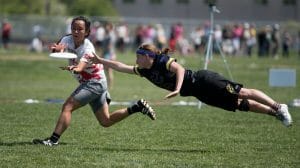
When it comes to awards, the internet, and ultimate, hyperbole has found a premier breeding ground. Lauren Sadler’s defensive capabilities turn exaggerations into reality. When someone says she gets a layout D every game, they are being sincere. When they say she wins one on ones that she has no right to, they aren’t lying. When it comes to defense, Sadler has a knock for generating turnovers, often in spectacular fashion.
Less spectacular is the intense work ethic and motor Sadler plays with. She isn’t the biggest, fastest, nor does she jump the highest. But it is the relentless fervor she plays with that often precedes the huge layout D. There are so many other turnovers she creates from active hands, energetic feet, and physicality that don’t make the highlight reel.
She’s really the type of player every teams wants and the type of teammate players love. Her zest for grinding on D points and combination of consistency and playmaking made her this year’s most impactful defensive presence.
Runner-Ups: Caitlin Fitzgerald (Kansas), Hannah Leathers (Georgia)
Breakout Player of the Year
Han Chen (UCLA)
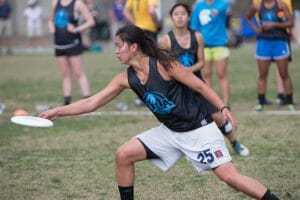
The potential for Han Chen’s continued growth is rather staggering, considering how impressive the start to her career has been. Better known on the west coast as Heist, the sophomore hybrid attacker is the kind of asset coach’s hanker for. She’s 5’10”, athletic, has great hands, extensive throwing range, and oozes confidence. When Chen plays, it is without fear and her refusal to back down is apparent in both cuts and throws. With too much size to be given deep and too much power to be given unders, Heist represents a “pick your poison” matchup for defenses.
As part of the power trio for UCLA, Chen helped lead a team in need of new playmakers to one of the top seeds at nationals and a very strong regular season. Often given room to work to start offensive points, she drew increasingly high rated defenders as teams struggled to find someone to match her. Her long arcing throws – particularly the forehand – opened up their offense dramatically and often left the defense out of the play entirely; even against a good mark, her size and range overpowered the D. She tallied the 7th most assists in the Women’s Division at Nationals, as just a sophomore.
And growth will continue. Chen’s defensive capabilities are mostly built around her size and athleticism, but the rest will come with time. Her understanding and vision will catch up to her immense talent. She’s filled a rare role, coming from outside of the major youth ultimate scene at an early point in career to fill a major role on an elite team.
Runner-Ups: Julia Butterfield (Notre Dame), Megan Chavez (Carleton)
Rookie of the Year
Ellen Au-Yeung (British Columbia)
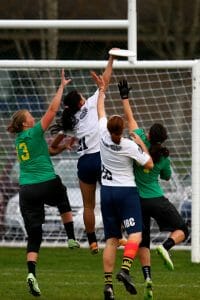
The explosive firebolt, Ellen Au-Yeung, made her mark on Milwaukee with huge plays and steady energy. She’s an exceptional athlete whose speed slices through the field and whose layouts and skies send shockwaves through a game. Coming in as arguably the star of Canada’s silver medal U19 team, the expectations were high, but Au-Yeung somehow surpassed them.
While Au-Yeung was making a very real impact from early in the season, Milwaukee was where her station was elevated. When UBC lost its star, Au-Yeung was one of the players they looked to to step up. She was instrumental in the team’s thrashing of Virginia in the quarterfinals and turned in a very strong semifinal performance to boot. Maturing as the season developed, her progress helped her climb the ranks of elite rookies and carve out a bigger and bigger space in UBC’s attack. She racked up 18 goals + assists at Nationals, the lead among rookies.
With a rare ability to takeover a point or turn the tide in a game, Ellen Au-Yeung was clearly a star in the making. It is likely she’ll be a key piece of the T-Birds attack and one of the country’s highest profile players for the remainder of her career.
Runner-Ups: Julianna Werffeli (Dartmouth), Ella Hanson (Oregon)
Coach of the Year
Jamie Nuwer/Robin Knowler/Jenny Wang (Stanford)
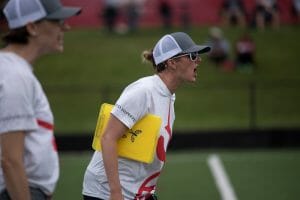
What’s impressive about Stanford isn’t that they reached the final or won the Southwest in dominating fashion. Sure, those things were great accomplishments and Superfly was expected to be good. Stanford’s veteran laden team had a lot of the tools that make a team a favorite.
What’s impressive about Stanford was that everyone on the team had a complete understanding and acceptance of their role. The coaching trio took a collection of players with mostly specialized skillsets and employed them in a manner that allowed everyone to reach their potential. Their rookies aren’t the most incredibly talented in the field, but they were trained to take advantage of their abilities and to do so with confidence. Wang guided their role players excelled in their specific roles, all of whom seemed excited to do it. Their handlers knew their jobs and even what function they operated in within their handler sets. And everyone was willing to do their part.
It was an outstanding season for Stanford, in large part due to their coaching masterminds, even if they’d humbly shove all the credit onto their players. Nuwer and Knowler are very strong X’s and O’s coaches, supported by the overarching adjustments of Wang, able to make the incremental achanges in a manageable fashion. But above all else, they took a set of parts and turned them into a greater whole capable of playing some of the best ultimate in the women’s game this season.
Runner-Ups: David Allison (Virginia), Alex Korb (UCLA)